Jodrell Bank's role in early
space tracking activities - Part 2
Sven Grahn
Table of Contents
Part 1
- A strange new world
- The creation of the telescope
and the observatory
- How Jodrell Bank was drawn
into space tracking
- Space tracking exploits by
Jodrell Bank
- The Able program
- The U.S. Army/JPL lunar
probes
- Supporting the Able project
again
- The early Soviet Luna
probes
-
Luna 1 - whizzing past the moon - did anyone hear it?
-
Luna 2 - the first spacecraft to reach another celestial
body
-
Luna 3 - the first view of the moon's far side
Part 2
Tracking Soviet Interplanetary probes
Venera-1
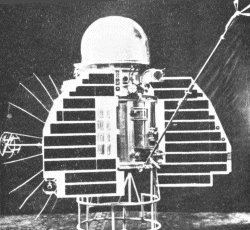 After
the Soviet lunar probe launches in 1958,1959 and early 1960 (see
table of Soviet Venus probe launches) their focus shifted to planetary
flights. In October 1960 two unsuccessful Mars probe launches were made
and the Venus probe launch window that opened in early February 1961 was
also used by the Soviet Union. The first launch on 4 February failed when
the last stage of the launch vehicle was stranded in earth orbit. The ullage
rocket module (BOZ) of the fourth stage did not fire when a DC converter
supplying power to the pyro timer failed (57).
However, the second probe, Venera-1 (manufacturer's code; 1VA) smoothly
left earth orbit on 12 February 1961. We now know (55)
that objective was to hit Venus and the forward dome of the probe may have
been some sort of thermal cover, so that the probe would reach as
far down as possible while relaying data, and so that something would actually
reach the surface. Soviet media did not mention the
intention to hit Venus when they published a rather extensive description
of the probe and its mission. In the TASS statement the transmission frequency
of 922.8 MHz of the Venera 1 probe is mentioned, the first time that this
frequency was ever given as a telemetry frequency for a Soviet space vehicle.However,
the Soviet tracking network soon lost contact with the probe.
After
the Soviet lunar probe launches in 1958,1959 and early 1960 (see
table of Soviet Venus probe launches) their focus shifted to planetary
flights. In October 1960 two unsuccessful Mars probe launches were made
and the Venus probe launch window that opened in early February 1961 was
also used by the Soviet Union. The first launch on 4 February failed when
the last stage of the launch vehicle was stranded in earth orbit. The ullage
rocket module (BOZ) of the fourth stage did not fire when a DC converter
supplying power to the pyro timer failed (57).
However, the second probe, Venera-1 (manufacturer's code; 1VA) smoothly
left earth orbit on 12 February 1961. We now know (55)
that objective was to hit Venus and the forward dome of the probe may have
been some sort of thermal cover, so that the probe would reach as
far down as possible while relaying data, and so that something would actually
reach the surface. Soviet media did not mention the
intention to hit Venus when they published a rather extensive description
of the probe and its mission. In the TASS statement the transmission frequency
of 922.8 MHz of the Venera 1 probe is mentioned, the first time that this
frequency was ever given as a telemetry frequency for a Soviet space vehicle.However,
the Soviet tracking network soon lost contact with the probe.
According to a message to Jodrell Bank from Dr Alla
Massevitch the last contact with Venera 1 occurred on 17 February 1961
at 1404-1535 MT. Dr Massevitch explained in another report (53)
that the probe "was designed to transmit signals every five days. For
about 17 minutes it should have sent out an unmodulated sound, and then
transmitted coded messages giving scientific information such as temperature,
pressures, and the presence of meteorites." So, presumably, the
probe malfunctioned some time between 17 and 22 February 1961. However,
Soviet tracking stations had computed that the probe would indeed pass
near Venus and asked Jodrell Bank to try to pick up telemetry from the
probe when it passed closest to Venus on 17 May 1961. Presumably a command
to switch on the probe's transmitter was sent from the main Soviet ground
station in the Crimea. Jodrell Bank did pick up unidentified signals on
922.8 MHz on 17 May 1961 and sent them to Moscow for analysis. Obviously
nothing relating to Venera 1 had been heard since Soviet authorities never
claimed to have regained contact with the probe.
However, Soviet authorities did not lose all hope of contacting
the probe. Soviet scientists Drs Massevitch and Khodarev were invited
to Jodrell Bank by Prof. Lovell in a telegram dated 30 May 1961 and certainly
visited the observatory from 9-16 June 1961 and tried to pick up more signals
from Venera, but to no avail (53). Telegrams
from Moscow with pointing data for Venera 1 continued to be sent to Jodrell
Bank in support of this last-ditch reception attempt. The last telegram
from Moscow with pointing data for the Venera 1 probe that I could find
in the Venus probe file in the Jodrell Bank Archives is dated 20 June 1961.
Mars-1
In 1962 the new space probe model designed by the Korelev
design bureau, called "Object MV" (MV for Mars-Venera), capable of being
launched to both Mars and Venus was taken into use. The first launches
of this new spacecraft took place towards Venus on 25 August, 1 September
and 12 September 1962 (See
table of Soviet/Russian Mars probe launches). The Mars launch window
opened soon after the Venus window. Two Mars versions of Korolev's "Object
MV" was prepared for launch in 1962. MV-3 for landing on Mars and MV-4
for flying past the planet. Three launch attempts were mader on 24
October, 1 November, and 4 November. The first two attempts were fly-by
probes and the last was a landing attempt. Only the middle attempt made
it out of Earth orbit, the probe launched on 1 November and called Mars-1.
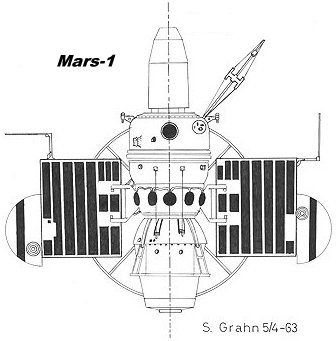 Soviet
media published an extensive description of the probe's mission and its
subsystems. The radio systems were described as follows: "The craft
carries three radio systems, working on wavelengths in the metre (1.6m),
decimetre (32cm) and centimetre (5 and 8 cm) ranges....The radio complex
working in the metre range serves both for transmission of telemetric information
about condition of the station and for maintaining communication with the
earth in the event of abnormal functioning of the orientation system."
(52)An
interpretation of this description can be found in Radio
Systems of Soviet Mars and Venus Probes.
Soviet
media published an extensive description of the probe's mission and its
subsystems. The radio systems were described as follows: "The craft
carries three radio systems, working on wavelengths in the metre (1.6m),
decimetre (32cm) and centimetre (5 and 8 cm) ranges....The radio complex
working in the metre range serves both for transmission of telemetric information
about condition of the station and for maintaining communication with the
earth in the event of abnormal functioning of the orientation system."
(52)An
interpretation of this description can be found in Radio
Systems of Soviet Mars and Venus Probes.
Obviously Jodrell Bank tracked the Mars 1 probe and telegrams
giving transmitter ON times for Mars-1 and pointing data were regularly
sent to Jodrell Bank from Moscow. It was necessary for Jodrell Bank to
know when the probe's transmitters would be on because they operated for
only an hour or so a day. For example, Mars 1 transmitters would be operating
at 0850-1040 Moscow Time on 27 November 1962, at 0825-0955 Moscow Time
on 7 December 1962, and at 1700-1830 Moscow Time on 15 January 1963. Until
13 December 1962 the probe operated at regular two-day intervals between
communications session and then changed to five-day intervals (52).
Moscow even gave (44) details about the radio
systems of Mars 1: "The telemetry transmitter operates on 922.8 MHz
with +/- 120 deg phase modulation with the subcarrier frequency in the
range 1100-1700 Hz, during telemetry transmission the subcarrier frequency
is modulated in frequency by a code signal." All went well for Mars-1
for the first five months, but on 21 March 1963 all contact with the probe
was lost due to an orientation system problem. Mars-1 is estimated to have
passed Mars at a distance of 193000 km on 19 June 1863.
Zond 1 and 2
Zond 1 was launched on 2 April 1964 but no target was given
for the flight. However, most observers guessed that it was aimed at Venus.
Moscow gave technical details about the flight: On April 4 TASS described
a course correction at 1818 UT on April 3 and stated that "telemetric
information from Zond 1 is coming in on a frequency of 922.76 MHz." (51).
This revelation of the transmission frequency must have been aimed at stations
such as Jodrell Bank and the observatory successfully located the Soviet
space probe Zond 1 shortly after its launch (47).
A course correction was made on May 14 when the probe was 13 million kilometres
from the Earth (50).
An unsuccessful search with the 75 m Mark I telescope was made during the
predicted time of closest approach to Venus 17-21 July 1964 (47).
Jodrell Bank was also successful in picking up the Zond
2 probe launched to Mars on 30 November 1964. Contact with the probe was
irregular and uncertain according to (47).
This
seems to contradict a magazine report (48)
which stated that Zond 2 was received regularly by Jodrell Bank. In January
1965 and at around 2100 UT on 3,10 and 17 February 1965 signals were picked
up using the 15 meter dish at Jodrell Bank. In the same report a
visit by Soviet scientists to Jodrell Bank on 17 February 1965 is described.
Academician Keldysh was asked whether Jodrell Bank would be requested to
track any Soviet space probe in the future and replied "We shall whenever
it is necessary". On May 5, Gennadi Skuridin, on a visit to the
U.S., reported that "Transmissions from Zond 2 have stopped. We have
been unable to raise it again". (49)It
flew past Mars silently on 6 August, 1965.
Venera 4 - Jodrell Bank tracks the
first in a series of instrumented entries in the atmosphere of another
planet
|
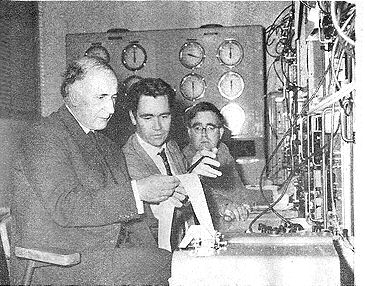
Jodrell Bank during the
tacking of Venera-4. From the left:
A.C.Bernard. Lovell, John G. Davis, Robert
Pritchard.
|
Venus probe launch attempts continued to be carried out in
1962, 1964 and 1965 (see
table of Soviet Venus probe launches) but all failed for various
reasons. In 1962 the new space probe model, designated "Object MV" (MV
for Mars-Venera), capable of being launched to both Mars and Venus was
taken into use. The first launches of this new spacecraft took place on
25 August, 1 September and 12 September 1962. The first two (model 2MV-1)
were aimed at landing a capsule on Venus and the third (model 2MV-2) was
an attempt at a fly-by of Venus. These launches all failed, leaving the
fourth stage stranded in earth orbit. One must remember that in August
1962, NASA launched Mariner 2, that flew by Venus in December 1962. The
space race was really hot! In the spring of 1964 four
more attempts at reaching Venus were made. Zond-1 was the only probe in
that series that actually headed out to Venus, but it failed before reaching
its fly-by of the planet. Another batch of five Venus attempts were made
in 1965. Two landings and two fly-bys were attempted. Only two probes reached
an interplanetary trajectory. Venera 2 did fly by Venus and Venera 3 probably
hit Venus, but the probes both failed before reaching their target.
The first space probe that reached the
surface of Venus in working condition was Venera 4. It was launched on 12
June 1967 and entered the atmosphere of Venus on 18 October 1967. The
384 kg capsule transmitted data for 94 minutes. The capsule was
crushed by atmospheric pressure at 18 bar when it was at an altitude
of 22 km experiencing an outside temperature of 274oC.
It dropped to the surface of Venus at a point near 19N 38E longitude.
Jodrell Bank tracked the
flight's approach to the surface. The observatory picked up signals from Venera
4 at 0317 UT on 18 October 1967, some
forty minutes after Venus rose above the horizon. The signals were similar
to those that Jodrell Bank had picked up in July 1967. The signal was described
(56)
as "two tone telemetry similar to the Lunik's transmissions but speeded
up four times." Doppler shift measurements were made and they showed
that the distance to venus was 30000 km at 0440 BST and the probe accelerated
along the line-of-sight with 0.3 m/s2.
The received signal strength was -140 dBm. Jodrell Bank expected, that
if the probe would orbit Venus, it would slow down and the Doppler shift
would reveal that between 0403 and 0450 UT. But, no such slowing down was
noticed, rather the opposite. the probe continued to accelerate towards
the surface and at 0415 UT the probe was estimated to have been 10000 km
form the surface. At 0438:05 UT the signals ceased, at an estimated altitude
of 100 km. Fifteen seconds later the signal re-appeared on the same frequency,
at 20 dB down and with a much reduced data rate. The Doppler shift in this
signal was very small and initially, the Jodrell Bank team thought the
capsule rested on the surface. The signals ceased finally at 0614 UT.
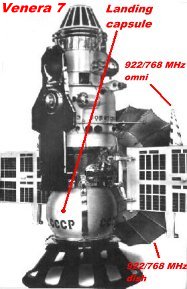
There was not enough time to redesign the next batch of
Venus probe, so Venera 5 and 6 met the same fate as Venera 4. Venera 5
survived for 53 minutes in the atmosphere and reached 26 km from
the surface. Venera 6 said to have survived to 10-12 km altitude 51 minutes
after atmospheric entry. (54) The
landing capsules of the next batch of two Venus probes launched in August
1970 were modified to survive to the surface. One probe failed to leave
Earth orbit and was given the cover name Kosmos 359. Venera 7, launched
on 17 August 1970, was equipped with a redesigned landing capsule that
could stand 180 atm and 540oC.
Radio signals appeared to stop after 35 minutes, but weak signals, 20 dB
down, were found (by post-flight signal processing) to have continued
for 23 minutes. The capsule landed at 5oS,
351o longitude. The
environment on the surface measured to be 90 +/- 15 atm, 475 +/- 20oC.
The following probe, Venera 8, launched on 27 March 1972, had a detachable
antenna to solve the previous probe's problem and worked very well. The
environment on the surface was 470 +/- 8oC,
93 atm.
Ranger tracking
Signals from the two US Moon probes Ranger 6 and Ranger 7
were received on 960 MHz using the 15 meter altitude/azimuth telescope
in conjunction with a parametric amplifier. Ranger 6 was tracked until
the moment of impact with the Moon on 2 February 1964, while Ranger 7 was
followed on 31 July 1964 until it disappeared below the western horizon
about one hour before impact. (47)
Luna 4-14, the second-generation Soviet lunar probes
It took three and a half years from the astounding success
of Luna 3 until the Soviet Union again launched a lunar probe. When these
new probes finally appeared observers assumed - correctly - that the goal
was to soft-land a probe on the moon. The new series would again thrust
Jodrell Bank into the limelight! It started with two failures, the first
on 4 January 1963 when the probe was stranded in earth orbit (1963-01A,
Sputnik 25), and the second on 2 February 1963, when the probe did not
reach orbit and fell into the Pacific These failures were not immediately
known to the public.
Luna 4,5,6,7,8 - trying again
and again to land on the moon
The first of these new Luna probes that was announced
as such was Luna 4, launched on 2 April 1963. The Soviet Union did
not ask Jodrell Bank to track the flight, but Jodrell Bank finally acquired
Luna 4 during 6 hours on 4 April after searching for it since 2 April (31).
Signals were far more complicated than those from Luna 3. On the day it
flew past the Moon (at 0124 UT at a distance of 8500 km), 6 April, signals
were recorded for 44 minutes, but there were no signs of firing of retro-rockets
at the Moon (19). 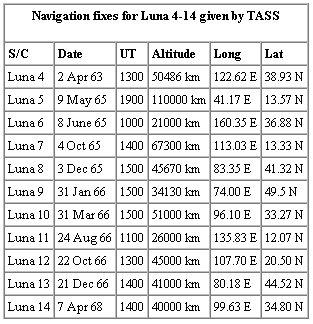 Despite
the lack of a direct request for support from the USSR, Soviet media gave
the transmission frequency - 183.6 MHz (32),
and also the traditional position fix giving a distance from the earth
at certain geocentric co-ordinates at a defined instant. This was clearly
an invitation to monitor signals in order to obtain independent confirmation
of Soviet claims. The table on the left shows the navigation fixes for
Luna 4-14 published in the official launch communiqués from TASS
(33).In
addition to the tracking reports from Jodrell Bank, the US National Security
Agency had arranged with the Naval Research Labs in Maryland to use its
45 m dish to track Luna 4. Because the flight to the moon took 88 hours
instead of 80 hours even a station as far west as on the US east coast
could pick up the signals on 183.6 MHz, which were "complicated and full
of variety"
(2). (see Luna 4-14
radio systems
for a detailed
description).
Despite
the lack of a direct request for support from the USSR, Soviet media gave
the transmission frequency - 183.6 MHz (32),
and also the traditional position fix giving a distance from the earth
at certain geocentric co-ordinates at a defined instant. This was clearly
an invitation to monitor signals in order to obtain independent confirmation
of Soviet claims. The table on the left shows the navigation fixes for
Luna 4-14 published in the official launch communiqués from TASS
(33).In
addition to the tracking reports from Jodrell Bank, the US National Security
Agency had arranged with the Naval Research Labs in Maryland to use its
45 m dish to track Luna 4. Because the flight to the moon took 88 hours
instead of 80 hours even a station as far west as on the US east coast
could pick up the signals on 183.6 MHz, which were "complicated and full
of variety"
(2). (see Luna 4-14
radio systems
for a detailed
description).
Two more launch attempts were made in 1964. The first
launch took place on 21 March and failed when he thirs stage did not reach
full thrust. The second attempt took plcae less than a month later, on
20 April 1964, when the third stage again cut off prematurely.
A year later, in the spring of 1965, this spacecraft series
resumed with attempts to land on the Moon - the so-called E6 probe. The
first two attempts failed. The probe launched on 12 March 1965 was left
stranded in Earth orbit as Kosmos 60, while probe launched on 10 April
never reached orbit due to a third stage failure. On 9 May Luna
5 finally was injected
into a trans-lunar trajectory. Both the new NSA station at Asmara, Ethiopia (See
article on the US
"Deep-Space
Collection"
programme), and Jodrell Bank tracked Luna 5 which transmitted
similar telemetry to that from Luna 4. The Asmara station intercepted "both
of the two spacecraft signals several times during the mission, and both
Asmara and Jodrell Bank were listening during the final approach to the
moon" (2). Two signals - indeed! 183.6
MHz and what other frequency? 922.7 MHz? However, the Doppler measurements
made at Jodrell Bank revealed no signs of retro-rocket firing from Luna
5 (20). Luna 6 was
launched on 8 June 1965, but the course-correction was not turned off correctly
on 9 June causing the probe to miss the Moon by 161000 km and enter heliocentric
orbit. Luna 7 was launched on 4 October 1965. From observations
made at Jodrell Bank (20) it was conclude
that the retrorockets of Luna 7 were in operation during the period 2058-2104
UT on 7 October 1965. However, this turned out to be wrong. According to
what we know now (61) the retro-rocket
never fired because the earth sensor lost lock just before ignition. The
probe crashed into the Moon at 2208.24 UT. Luna 8 was launched on
3 December 1965, but thus time the retrorockets fired too late. Signals
received at Jodrell Bank from Luna 8 ceased at 2151.32 UT on 6 December
1965 (21), which we now know was the moment
of impact. The retro-rocket did not ignite.
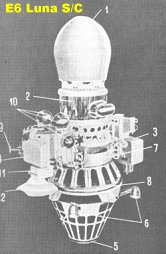 Luna
9 - the first landing on the moon
Luna
9 - the first landing on the moon
The tracking of Luna 9 was to become Jodrell Bank's most
spectacular, dramatic, and controversial appearance in the media. Luna
9 was launched from Baikonur on 31 January 1966 and was immediately
recognized by all observers as another Soviet attempt to land an instrument
package on the moon. The moon rose at Jodrell Bank on 3 February 1966 at
1333 UT. Signals from Luna 9 were received starting at 1629 UT until landing
at 1845 UT. After a few minutes of silence the signal reappeared. Ten minutes
later it changed character and the signal was recognized as facsimile because
it was similar to signals used in transatlantic transmissions experiments
using the Echo II balloon satellite (27).When
I visited Jodrell Bank in September 1967 the public affairs officer, Reginald
Lascelles, explained that he had been the person identifying the
signal as being facsimile, because of this previous employment in newspapers
where he had heard the characteristic sound of facsimile signals! Be that
as it may - someone recognized the signal as facsimile!
The pictures from Luna 9 were received on 4 February 1966
at 1530-1655 UT and again on 5 February at 1640-1740 UT. Other facsimile
transmissions were received on 3,4 and 6 February "which we have not seen
as photos" (22) . Jodrell Bank recorded
long series of telemetry bursts, each lasting six minutes and corresponding
to one picture (23). The international
facsimile standard is that the White/black transition corresponds to a
a change in audio frequency between 1.5 to 2.3 kHz, while the Luna 9 transmissions
used a change from 1.2 to 2.0 kHz. The difference in horizontal/vertical
ratio was sometimes given as a factor 2 and sometimes as a factor 2.5 .
The picture signals were transmitted on a subcarrier with maximum deviation
of 2 kHz. The synchronization signal for the pictures (start of each line?)
was a tone with the frequency 1.1 kHz (24).
The lunar panoramas consisted of vertical lines with 500 elements (each
3.6 minutes of arc wide) and the 360 degree view around the horizon consisted
of 6000 such lines (25). Jodrell Bank
recorded the Luna 9 pictures on a Mincom CM-110 tape
recorder (62) .
The fact that Jodrell Bank used a standard facsimile receiver
(borrowed from the Daily Express in Manchester) to print the pictures coming
in from the moon and did not recognize that the horizontal/vertical ratio
did not conform to the international standard led to an exchange of harsh
words with Soviet Academy of Sciences. Naturally, the Soviet authorities
would have liked to publish the pictures at their own initiative and used
the fact that the pictures published by Jodrell Bank were not quite correct
as a pretext for complaining about about the premature release of the pictures.
Prof. Lovell defended himself by pointing out the great general interest
of the pictures from moon and that the pictures still showed the correct
qualitative characters of the lunar surface. This conflict with Soviet
authorities is not only evident from public exchanges, but also from correspondence
in the Jodrell Bank Archives where I found a letter (43)
from the Academy of Sciences of the USSR complaining about the "hurried
publication of the Luna 9 pictures" by Jodrell Bank.
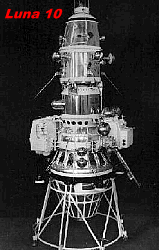 Incredibly,
just as in the case of Luna 2 there were disbelievers that asked Jodrell
Bank for proof of this latest Soviet feat. Thus, The "Anti-Communist League
of America, Inc." (Carrying the text: "Communism must be destroyed" in
its letterhead) wrote (26) to request
information about the descent phase of Luna 9. In reply, they received
a reprint of the article in Nature about Jodrell Bank's reception of signals
from Luna 9 (28).
Incredibly,
just as in the case of Luna 2 there were disbelievers that asked Jodrell
Bank for proof of this latest Soviet feat. Thus, The "Anti-Communist League
of America, Inc." (Carrying the text: "Communism must be destroyed" in
its letterhead) wrote (26) to request
information about the descent phase of Luna 9. In reply, they received
a reprint of the article in Nature about Jodrell Bank's reception of signals
from Luna 9 (28).
Luna 10, 11, and 12 - shifting
the focus to lunar orbit
When Luna 9 had succeeded in landing on the moon, the
Soviet focus immediately shifted to putting a probe into orbit around the
moon. In February 1966, Kosmos 111,a failed lunar probe was launched [give
details about reason for failure and details such as HF frequency]. Another
attempt, this time successful, was made on 31 March 1966, when Luna 10
was launched. Jodrell Bank successfully tracked the probe, detected its
insertion into lunar orbit and measured its period (35).
Other tracking stations, such as the Bochum Space Observatory in Germany,
also picked up the probe, including the transmission of the tune "The
International" (38 kB mp3) at 1944-1950 UT on
3 April 1966 (34) . This transmission was
made to celebrate the 23 rd Congress of the CPSU. The two following probes
in the E6 Luna series were also orbiters. The character of Luna 11
has been hotly debated and some authors think that Luna 11 was similar
to Luna 10, i.e. it had a non-stabilized orbiter, while other space historians
think it was similar to Luna 12, which did not separate a payload in lunar
orbit and actually produced pictures of the moon. The only evidence, although
inconclusive, as to the character of Luna 11 found in the Luna 11 archives
is a statement (36) by Prof. Lovell explaining
that "we received facsimile signals for a short time from Luna 11 which
appeared to be of identical form to those transmitted by Luna 9. However,
it proved impossible to make anything of the information."
I found nothing about Luna 12 in the Jodrell Bank Archives.
Perhaps this was due to the fact that special measures were taken to ensure
that Jodrell Bank would not be able to repeat its Luna-9 scoop during the
Luna-12 mission (59 p. 46). One option considered
was to gradually send back the pictures during the brief windows that Luna-12
was only within range of the Crimea, which could pick up the spacecraft
three hours before it entered Jodrell Bank’s radio visibility zone. However,
in that mode "it would have taken months" for the pictures to trickle
down to Earth. Another solution was found, enabling the Russians to send
back the pictures in 24 hours, while still leaving Jodrell Bank empty-handed.
As one of the Lavochkin bureau veterans explained : “We were able to
send back information in two bands, the metre and decimetre bands, and
to quickly switch from one band to the other, while Jodrell Bank needed
about a day to reconfigure its equipment [for this] ... That is the way
we worked : we made full use of the [three hour Soviet window] and then,
as the probe came within range of Jodrell Bank, began alternating between
the two modes in varying sequences, playing cat and mouse with Jodrell
Bank. We successfully completed our nearly round-the-clock work to send
back the images and breathed a sigh of relief. It was as if a great weight
had been lifted from our shoulders." (59)
Luna 13 and 14
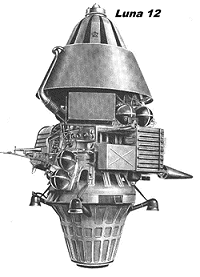 After
Luna 12 The Soviet union launched a second lunar lander, Luna 13,
equipped with several new devices, including a device to measure the hardness
of the lunar surface. Jodrell Bank tracked Luna 13 and received images
in the same fashion as from Luna 9. The final launch
in this series occurred almost 18 months later, on 7 April 1968. It was
Luna
14 and pictures of the Luna 12 probe (which it probably resembled)
show a conical antenna obviously intended for the standard 768/922 MHz
TT&C system. It has been reported that Luna 14 was a test of various
subsystems for the next generation of Luna probes, including the drive
system for the Lunokhod lunar rovers. There is a message (45)
in the Jodrell Bank Archives to professor Lovell while he was in the U.S.
that the observatory had picked up Luna 14: "PLEASED TO INFORM YOU SIGNALS
FROM LUNAR ORBITER 14 RECEIVED.". Of course the telegramme refers to
Luna 14.
After
Luna 12 The Soviet union launched a second lunar lander, Luna 13,
equipped with several new devices, including a device to measure the hardness
of the lunar surface. Jodrell Bank tracked Luna 13 and received images
in the same fashion as from Luna 9. The final launch
in this series occurred almost 18 months later, on 7 April 1968. It was
Luna
14 and pictures of the Luna 12 probe (which it probably resembled)
show a conical antenna obviously intended for the standard 768/922 MHz
TT&C system. It has been reported that Luna 14 was a test of various
subsystems for the next generation of Luna probes, including the drive
system for the Lunokhod lunar rovers. There is a message (45)
in the Jodrell Bank Archives to professor Lovell while he was in the U.S.
that the observatory had picked up Luna 14: "PLEASED TO INFORM YOU SIGNALS
FROM LUNAR ORBITER 14 RECEIVED.". Of course the telegramme refers to
Luna 14.
Tests of a Soviet piloted circumlunar spacecraft - Zond
4-8
Launches in 1967
The Zond designation was confusingly used also for the
series of Soviet space vehicles that tested a manned circumlunar spacecraft.
Perhaps the intention was to be able to hide the true nature of these craft
in the case the program failed. The first two test launches of these Zond
craft (see "The
continuing enigma of Kosmos 146 and Kosmos 154") were mainly tests
of the propulsion system needed to leave earth orbit. Kosmos 146 seems
to have been partially successful, while Kosmos 154 was a failure because
the ullage rockets needed to restart the last stage of the Proton launch
vehicle were discarded prematurely. During the second half of 1967 the
Soviet Union made extensive efforts to launch the first "full-up" unpiloted
test of the Zond circumlunar mission. After several attempts in August
and September the launch finally occurred at 1907:59 UT on 22 November
1967 (42). Analysis (see "Mission
profiles of 7K-L1 flights") shows that this launch was aimed at
the moon, but the launch failed due to a second stage engine failure.
Zond 4 and the launch attempt
in April 1968
The next launch, of Zond 4, took place at 1828 UT on 2
March 1968 and, strangely, it was launched on an elliptical orbit
away from the moon. [Explain fate]. It is unclear if Jodrell Bank tracked
this flight. Russian media were very reticent concerning this flight. The
next launch attempt in the Zond program occurred very soon after Zond 4.
A Zond was launched in the direction of the moon at 2301:57 UT on
22 April 1968 (42). This flight also failed
because premature cutoff of the second stage due to a short
circuit.
Zond 5 - a strange Soviet game
of hide-and-seek and voices from the sky
The next launch took place after the summer of 1968 when
Zond 5 was sent on a circumlunar trajectory in September. Jodrell Bank
certainly 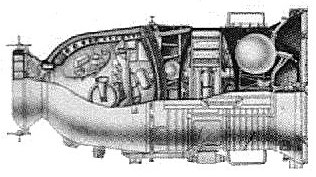 tracked
this flight, but antenna pointing angles in all probability did not come from
the Russians, but rather from the
U.S. Deep-Space Collection Programme
. From press reports we know that Jodrell
Bank intercepted signals, including voice signals uplinked to the spacecraft
from Yevpatoria and returned by the spacecraft to simulate the presence
of a cosmonaut. These Zond spacecraft did not transmit in intermittent
communications sessions as the Luna probes, but instead their transmitters
were operating continuously on 922.76 MHz. (See
Zond 4-8 radio systems) In the case of Zond 5, Soviet authorities
played a bizarre game of cat-and-mouse with the media, initially denying that
the spacecraft was going to the moon:
tracked
this flight, but antenna pointing angles in all probability did not come from
the Russians, but rather from the
U.S. Deep-Space Collection Programme
. From press reports we know that Jodrell
Bank intercepted signals, including voice signals uplinked to the spacecraft
from Yevpatoria and returned by the spacecraft to simulate the presence
of a cosmonaut. These Zond spacecraft did not transmit in intermittent
communications sessions as the Luna probes, but instead their transmitters
were operating continuously on 922.76 MHz. (See
Zond 4-8 radio systems) In the case of Zond 5, Soviet authorities
played a bizarre game of cat-and-mouse with the media, initially denying that
the spacecraft was going to the moon:
"What happened at the moon
at 0455 UT this morning[18 Sept 1969]? The head of the Jodrell Bank observatory
in England, professor Bernard Lovell, says that a Soviet spacecraft rounded
the moon and started on its way back to earth at that time. A few hours
later this report was denied by a spokesman of the foreign office
in Moscow. The report does not agree with facts, he said. At Jodrell bank,
engineers monitored signals all night from a spacecraft near the moon.
They heard signals regularly at 40 minute intervals. At 0455 UT this morning
they found that the spacecraft had circumnavigated the moon at a minimum
distance of 1500 km. The craft then headed back to earth along an elliptical
trajectory. No retrorockets were fired...." (40)
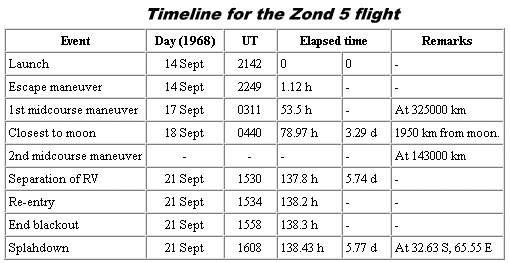 After
Zond 5 had passed the moon there were more surprises in store for those
monitoring the flight at Jodrell Bank: "On the night of 19-20 September,
the craft was clearly observed by Jodrell Bank to be on the return swing
and a Russian voice, presumably tape-recorded, was heard calling out instrument
values, as though communications were being tested for a subsequent manned
mission." (39). It turned out that
such voice signals were also picked up by the Bochum space observatory
(41).
According to the observatory's director, Heinz Kaminski, the voice had
been either sent from Earth to the spacecraft or the other way by means
of a tape recorder.
After
Zond 5 had passed the moon there were more surprises in store for those
monitoring the flight at Jodrell Bank: "On the night of 19-20 September,
the craft was clearly observed by Jodrell Bank to be on the return swing
and a Russian voice, presumably tape-recorded, was heard calling out instrument
values, as though communications were being tested for a subsequent manned
mission." (39). It turned out that
such voice signals were also picked up by the Bochum space observatory
(41).
According to the observatory's director, Heinz Kaminski, the voice had
been either sent from Earth to the spacecraft or the other way by means
of a tape recorder.
On Friday 20 September, TASS finally ended the bizarre
hide-and-seek and announced that Zond 5 had passed within 1950 km of the
moon's surface at 0440 UT on 18 September and was heading back to earth.
(See table below for a complete timeline of the Zond 5 flight). The flight
ended on 21 September 1968. Jodrell Bank lost contact at 1500 UT on 21
September 1968 when the spacecraft was 80000 km from earth. The descent
vehicle separated at 1530 UT and re-entry started at 1554 UT. The radio
black-out period ended at 1558 UT and splashdown occurred at 1608 UT in
the Indian Ocean off Madagascar.
Zond 6 - a dress rehearsal
that went wrong?
Zond 6 was launched at 1911:31 UT on 10 November 1968,
rounded the Moon at a distance of 2420 km on 14 November and on 17 November
it made a skip-lob re-entry into Soviet airspace. Howeveer, the re-entry
capsule crashed to the ground because of a faulty parachute, but the pictures
take at the Moon could be rescued and published. In this way the flight
was erroneously regarded by many Western observers as a complete success
leading up to a piloted circumlunar flight within short. Very little information
about Jodrell Banks' tracking of Zond 6 can be found in the Jodrell Bank
Archives, but they do contain the typed text of a statement to the press
dated 14 November 1968: Zond 6 passed behind the Moon from 0350 to 0420
a.m. (given as 0250-0320 UT in (37).
) at a distance similar to that of Zond 5, that is between 1000 and
2000 miles. There was no guidance or firing of retrorockets and the Zond
now appears to be on its return journey to earth. Tracking is continuing
until the probe sets early this afternoon and will be resumed tonight.
The only other document about the Zond flights found in the "lunar probes"
file of the Jodrell Bank Archives is a letter from Prof. Lovell to Prof.
DWR Wilson, University of Alberta, dated 27 November 1968 in which he explained
that "...Zond 5 and 6 set below our horizon several hours before re-entry.."
Zond 7
In August 1969, a few weeks after the flight of Luna 15
and Apollo 11, the Soviet Union launched the next Zond flight, but it was
still unmanned. It was the first, and as it turned out, only really successful
flight in the Zond series. Jodrell Bank tracked the flight and informed
the media that Zond 7 also transmitted voice communications, and that signals
were much stronger than those from Zond 6 (38).
We now know that yhis observation is explained by the fact that the high-gain
antenna on Zond-6 did not deploy, while it apparently did on Zond-7. (60).
Luna 15-24
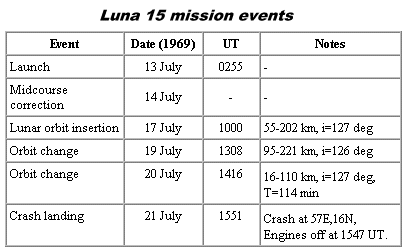 Perhaps
the monitoring of these Soviet attempts to beat the Apollo programme by
a series of unmanned lunar probes was Jodrell Bank's last major public
appearance as a space tracking station. Luna 15, the
first attempt to "beat" Apollo, was launched three days ahead of Apollo
11 and the media immediately saw a drama unfolding: The unmanned Soviet
lunar probe with an unknown mission - but probably a lunar sample return
- and the first attempt at a a manned lunar landing.
Perhaps
the monitoring of these Soviet attempts to beat the Apollo programme by
a series of unmanned lunar probes was Jodrell Bank's last major public
appearance as a space tracking station. Luna 15, the
first attempt to "beat" Apollo, was launched three days ahead of Apollo
11 and the media immediately saw a drama unfolding: The unmanned Soviet
lunar probe with an unknown mission - but probably a lunar sample return
- and the first attempt at a a manned lunar landing.
Jodrell Bank again came to play a major role in monitoring
the flight and in interpreting the flight events to the general public.
Professor Lovell noted that the probe was on a "slow" trajectory to the
Moon, taking a day longer to reach the Moon that previous Luna flights.
On July 17, as Luna 15 entered lunar orbit, Jodrell
Bank reported that the signals from Luna 15 "are of an entirely new
type never heard before." (46)
It is hard to know if this means that Jodrell Bank had never before tracked
a Luna probe on 922.8 MHz (which we know was used by Luna 15) or that the
telemetry format was much different (See Radio
Systems used by the Luna 15-24 series of spacecraft). At this time
Jodrell bank was co-operating closely with the US Deep Space Collection
effort and this organization may have helped Jodrell Bank find the correct
frequency and location the spacecraft in the sky.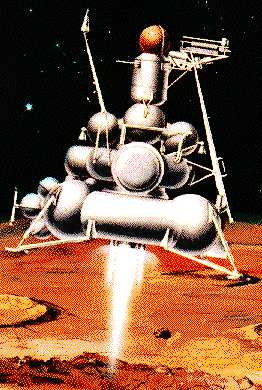 However,
Jodrell Bank provided the news about the final phase of the Luna 15 drama
in a news release:
However,
Jodrell Bank provided the news about the final phase of the Luna 15 drama
in a news release:
"Signals ceased at 4.50 p.m. this evening
[1550 UT on 21 July 1969; Soviet news releases gave the time as 1551 UT].
They have not yet returned. The retrorockets were fired at 4.46 p.m. [1546
UT; Soviet news releases gave the time as 1547 UT] on the 52nd orbit and
after burning for 4 minutes the craft was on or near the lunar surface,
The approach velocity was 480 km/h [presumably determined by measuring
the Doppler shift] and it is unlikely of anything could have survived."
There was a bizarre incident during the flight. In the U.S.
the notion was raised that Luna 15 could possibly interfere with Apollo
11 in some way. NASA let Frank Borman, commander of Apollo 8, approach
the Soviet Academy of Sciences to find out if there was any risk of radio
interference to Apollo 11 from Luna 15 operations near the Moon. The Soviets
replied and it seems that the frequency 115 MHz was raised in this exchange.
Suppose Luna 15 had worked perfectly, would it have beaten
Apollo to returning the first lunar samples to earth? By using the flight
profiles of Luna 16,20 and 24 one can deduce that Luna 15 could have returned
to earth 12.44 days after launch. This would be July 25.565 (i.e. at 1334
UT on July 25, almost a day after the splashdown of Apollo 11, which took
pace at 1635 UT on 24 July! So, Apollo 11 would not have been beaten anyway!
Even if Luna 15 had been able to stick to the quickest return flight schedule
(that of Luna 16) it would have been back after 11.65 days, i.e. at 0100
UT on 25 July - even this after the return of Apollo 11!
Jodrell Bank and public opinion about the space race
Sir Bernard often spoke out openly about his opinion of various
space missions. In particular his comments that Apollo 8 contributed very
little to astronomy was misinterpreted. To the knowledgeable person his
statement is obviously true, but it was interpreted as a criticism of the
Apollo program in general. As an example of how the public reacted to Sir
Bernard's refreshing outspokenness is the following extract from a letter
from Mary N. Allen, 1441 Montgomery Street, apartment 6, San Francisco,
California, dated 30 December 1968: ".....I think you should recognize
that for millions of people around the world (not, I gather, excluding
many in the U.K.) you are the epitome of all that is bogus, washed up and
unscientific in weak, wobbling Old Britain. After, and usually before each
"space occasion", your silly, ignorant and often gushing utterances call
forth this awareness anew. ..."
References and Notes
-
Bernard Lovell, "Astronomer by
Chance", McMillan Books, London, 1991, ISBN 0-333-55195-8
-
James D. Burke, "Seven Years to
Luna 9",: Studies in Intelligence, Summer 1966
-
James D. Burke, "The Missing
Link", Studies in Intelligence, Winter 1978
-
"Venus 4 underscores U.S. delay", Aviation
Week, 23 October 1967, p.26
-
V.A. Kotelnikov, .M. Dubrovin, O.N. Rzhiga and A.M.
Shakhovsky. "Reception and investigation of the properties of radio signals
from Soviet Space Rockets".
-
Hearings before the Committee on Science
and Astronautics and Special Subcommittee on Lunik Probe, U.S. House of
Representatives, Eighty-Sixth Congress, First Session, U.S. Government
Printing Office, Washington D.C., 1959. The hearings were held during the
period May 11-29, 1959.
-
Martin Caidin, "Race for the Moon". William Kimber
Publisher, London 1960.
-
The Big Red Lie, Lloyd Mallan, Fawcett
Book no 417, New York, 1959.
-
A letter from the AFBMD dated
6 May 1958
-
J.G Davies, A.C.B. Lovell, Observations
of the Russian Moon Rockets Lunik II and III, Space Research 1, Proceedings
of the first COSPAR conference, 1960.
-
Letter from Professor Lovell to Prof.
Nesmeyanov of AN USSR, 9 December 1959.
-
Asif A. Siddiqi, "First to the
Moon", Journal of the British Interplanetary Society, Vol.51, pp.231-238,
1998.
-
Leonid I Sedov, "The Orbits Of
Cosmic Rockets Towards The Moon", presented at American Rocket Society's
14 the Annual Meeting, Sheraton Park Hotel,Nov 16-20,1959. ARS paper no
1051A-59.
-
Henry G. Plaster, "Snooping
on Space Pictures", Studies in Intelligence, Fall 1964.
-
"The Other Side of the Moon", Translated
from the Russian by J.B. Sykes, Pergamon Press, 1960.
-
A telegram from Prof. Davies
to SPACE CONN NASA WASH DC dated 8 October 1959. The telegram concluded
"RUSSIAN
PREDICTIONS FOR OCT 9 FOLLOW".
-
Swedish Daily Expressen for
Monday, 19 October 1959, p. 12: "Lunik saw 2/3 of the moon's far side"
-
Swedish Daily Expressen for
Tuesday, 27 October 1959, centre spread: "Pictures from space: the far
side of the moon".
-
A letter from Prof. Lovell to Brian
Harvey, dated 22 February 1966.
-
A letter from Prof. Lovell to Martin
Postranecky, Prague, dated 9 November 1965.
-
A letter from Prof. Lovell to Martin
Postranecky, Prague, dated 21 June 1966.
-
A letter from Prof. Lovell to E.M.
Shoemaker dated 11 February 1966.
-
A transcript of a seminar on Jodrell
Bank's reception of pictures from Luna 9 written by Eugene M Shoemaker
-
A letter from Prof. Lovell to E.M.
Shoemaker dated 6 April 1966.
-
A message from M Keldysh at
the Academy of Sciences of USSR
-
A letter from John Crippen,
Executive Secretary of "The Anti-Communist League of America, Inc."
dated 5 March 1966.
-
A telegram from Prof. Lovell to SATREV
NY (newspaper?)
-
J.G. Davies, Sir Bernard Lovell,
R.S. Pritchard, F.G. Smith, "Observations of the Russian Moon probe
Luna 9", Nature, February 26, 1966, pp. 848-850.
-
A telegram to SPACE CONN NASA WASH
DC dated 7 October 1959
-
Second telegram to SPACE CONN NASA
WASH DC from J.G. Davies dated 7 October 1959
-
"Lunik 4 believed to have failed in
Mission", Aviation Week & Space Technology, 15 April, 1963, p.38.
-
"Soviets Launch Lunik 4", Aviation
Week & Space Technology, 8 April, 1963, p.38.
-
Mastery of Cosmic Space by the USSR,
official TASS communiqués and materials from the central press 1957-1967,
Nauka Publishers, Moscow 1971.
-
A letter from Mr Heinz Kaminski,
of the Bochum Space Observatory in Germany, dated 30 September 1966, congratulating
Prof. Lovell on the Luna 9 success and attaching data from Bochum's observations
of Luna 10 during the period 3-5 May 1966.
-
A letter to Hans Schnabel dated
17 June 1966 Prof. Lovell wrote that "We made measurements on Luna 10
only during the first few days of its career". He goes on to note that
Jodrell Bank determined the orbital period to be 3 hours.
-
A letter to William Pickering,
director of NASA JPL, dated 30 September 1966.
-
Geoff Perry, day-to-day
log, entry for 10 November 1968.
-
Geoff Perry, day-to-day
log, entry for 12 August 1969.
-
K.W Gatland, "Robot Explorers"
-
Swedish Daily Expressen for
Wednesday, 18 September 1968: "Spacecraft rounded the moon. Who launched
it?"
-
Swedish Daily Expressen for
Friday, 20 September 1968, quoting a Reuters telegram.
-
Issue No. 10, 1998 of the Russian
magazine Novosti Kosmonavtiki
-
Letter to professor Lovell from
Mstislav Keldsyh of AN USSR dated 26 February 1966.
-
A telegram to Jodrell Bank from
Akademi Nauk in Moscow dated 10 January 1963 gave details about the
radio systems of Mars 1. The telegram was in Russian, but the Cyrillic
characters were transcribed in latin letters. Dr Stas Barabash at the Swedish
institute of Space Physics in Kiruna has helped me translate this telegram.
-
A telegram dated 10 April 1968
sent to "LOVELL WESBUROHOTEL NY" by R Pritchard.
-
Brian Harvey, The New Russian
Space Programme, John Wiley & Sons, 1996, p.130.
-
The COSPAR bulletin for 1964
(date unknown, I have only kept the relevant pages)
-
Flight International, 25 February
1965, "Jodrell Bank Tracks Zond 2".
-
Flight International, 20 May
1965
-
Flight International, 28 May
1964, "Zond 1 changes course".
-
Flight International, 9 April
1964, "Soviet probe heading for Venus?".
-
Pravda, 15 December 1962,
"First flight to Planet Mars".
-
Flight International, 22
June 1961, "Venus Probe Remains Silent".
-
Donald F Robertson, "Venus
- A prime Soviet Objective", Spaceflight, May 1992, pp.158-161.
-
Timothy Varfolomeyev, "The
Soviet Venus Programme",Spaceflight, February 1993, pp.42-43.
-
Nature, Vol. 216, October
28, 1967, p.321, "Landing on Venus".
-
Timothy Varfolomeyev,
" Soviet Rocketry that Conquered Space, Part 5, The First Planetary Probe
Attempts, 1960-64",Spaceflight, March 1998, pp.85-88.
-
Bernard Lovell, 'The Moon Match',
in "Summer Days"edited by M Meyer, Eyre & Methuen, London 1981, pp
123-131
-
Biography of Babakin published
in 1996.
-
Hendrickx, Bart, "The Kamanin
Diaries 1967-1968", JBIS Vol 53 No 11/12, Nov/Dec 2000, p.415
-
Hendrickx, Bart, Siddiqi, Asif,
Varfolomeyev, Timothy, "The tough road travelled: A new look
at the second generation Luna probes", JBIS, Vol. 53, 9/10, Sept/Oct 2000,
p. 340
- Mincom, a
now now-defunct division of 3M, which specialized in magnetic
tape recorders for instrumentation and sound recording.

 Back
to Part 1
Back
to Part 1
 Back
to Space Tracking Notes
Back
to Space Tracking Notes
 Soviet
media published an extensive description of the probe's mission and its
subsystems. The radio systems were described as follows: "The craft
carries three radio systems, working on wavelengths in the metre (1.6m),
decimetre (32cm) and centimetre (5 and 8 cm) ranges....The radio complex
working in the metre range serves both for transmission of telemetric information
about condition of the station and for maintaining communication with the
earth in the event of abnormal functioning of the orientation system."
(52)An
interpretation of this description can be found in Radio
Systems of Soviet Mars and Venus Probes.
Soviet
media published an extensive description of the probe's mission and its
subsystems. The radio systems were described as follows: "The craft
carries three radio systems, working on wavelengths in the metre (1.6m),
decimetre (32cm) and centimetre (5 and 8 cm) ranges....The radio complex
working in the metre range serves both for transmission of telemetric information
about condition of the station and for maintaining communication with the
earth in the event of abnormal functioning of the orientation system."
(52)An
interpretation of this description can be found in Radio
Systems of Soviet Mars and Venus Probes.
 After
the Soviet lunar probe launches in 1958,1959 and early 1960 (see
table of Soviet Venus probe launches) their focus shifted to planetary
flights. In October 1960 two unsuccessful Mars probe launches were made
and the Venus probe launch window that opened in early February 1961 was
also used by the Soviet Union. The first launch on 4 February failed when
the last stage of the launch vehicle was stranded in earth orbit. The ullage
rocket module (BOZ) of the fourth stage did not fire when a DC converter
supplying power to the pyro timer failed (57).
However, the second probe, Venera-1 (manufacturer's code; 1VA) smoothly
left earth orbit on 12 February 1961. We now know (55)
that objective was to hit Venus and the forward dome of the probe may have
been some sort of thermal cover, so that the probe would reach as
far down as possible while relaying data, and so that something would actually
reach the surface. Soviet media did not mention the
intention to hit Venus when they published a rather extensive description
of the probe and its mission. In the TASS statement the transmission frequency
of 922.8 MHz of the Venera 1 probe is mentioned, the first time that this
frequency was ever given as a telemetry frequency for a Soviet space vehicle.However,
the Soviet tracking network soon lost contact with the probe.
After
the Soviet lunar probe launches in 1958,1959 and early 1960 (see
table of Soviet Venus probe launches) their focus shifted to planetary
flights. In October 1960 two unsuccessful Mars probe launches were made
and the Venus probe launch window that opened in early February 1961 was
also used by the Soviet Union. The first launch on 4 February failed when
the last stage of the launch vehicle was stranded in earth orbit. The ullage
rocket module (BOZ) of the fourth stage did not fire when a DC converter
supplying power to the pyro timer failed (57).
However, the second probe, Venera-1 (manufacturer's code; 1VA) smoothly
left earth orbit on 12 February 1961. We now know (55)
that objective was to hit Venus and the forward dome of the probe may have
been some sort of thermal cover, so that the probe would reach as
far down as possible while relaying data, and so that something would actually
reach the surface. Soviet media did not mention the
intention to hit Venus when they published a rather extensive description
of the probe and its mission. In the TASS statement the transmission frequency
of 922.8 MHz of the Venera 1 probe is mentioned, the first time that this
frequency was ever given as a telemetry frequency for a Soviet space vehicle.However,
the Soviet tracking network soon lost contact with the probe.


 Despite
the lack of a direct request for support from the USSR, Soviet media gave
the transmission frequency - 183.6 MHz
Despite
the lack of a direct request for support from the USSR, Soviet media gave
the transmission frequency - 183.6 MHz 
 Incredibly,
just as in the case of Luna 2 there were disbelievers that asked Jodrell
Bank for proof of this latest Soviet feat. Thus, The "Anti-Communist League
of America, Inc." (Carrying the text: "Communism must be destroyed" in
its letterhead) wrote
Incredibly,
just as in the case of Luna 2 there were disbelievers that asked Jodrell
Bank for proof of this latest Soviet feat. Thus, The "Anti-Communist League
of America, Inc." (Carrying the text: "Communism must be destroyed" in
its letterhead) wrote  After
Luna 12 The Soviet union launched a second lunar lander, Luna 13,
equipped with several new devices, including a device to measure the hardness
of the lunar surface. Jodrell Bank tracked Luna 13 and received images
in the same fashion as from Luna 9. The final launch
in this series occurred almost 18 months later, on 7 April 1968. It was
Luna
14 and pictures of the Luna 12 probe (which it probably resembled)
show a conical antenna obviously intended for the standard 768/922 MHz
TT&C system. It has been reported that Luna 14 was a test of various
subsystems for the next generation of Luna probes, including the drive
system for the Lunokhod lunar rovers. There is a message
After
Luna 12 The Soviet union launched a second lunar lander, Luna 13,
equipped with several new devices, including a device to measure the hardness
of the lunar surface. Jodrell Bank tracked Luna 13 and received images
in the same fashion as from Luna 9. The final launch
in this series occurred almost 18 months later, on 7 April 1968. It was
Luna
14 and pictures of the Luna 12 probe (which it probably resembled)
show a conical antenna obviously intended for the standard 768/922 MHz
TT&C system. It has been reported that Luna 14 was a test of various
subsystems for the next generation of Luna probes, including the drive
system for the Lunokhod lunar rovers. There is a message  tracked
this flight, but antenna pointing angles in all probability did not come from
the Russians, but rather from the
tracked
this flight, but antenna pointing angles in all probability did not come from
the Russians, but rather from the
 After
Zond 5 had passed the moon there were more surprises in store for those
monitoring the flight at Jodrell Bank: "On the night of 19-20 September,
the craft was clearly observed by Jodrell Bank to be on the return swing
and a Russian voice, presumably tape-recorded, was heard calling out instrument
values, as though communications were being tested for a subsequent manned
mission."
After
Zond 5 had passed the moon there were more surprises in store for those
monitoring the flight at Jodrell Bank: "On the night of 19-20 September,
the craft was clearly observed by Jodrell Bank to be on the return swing
and a Russian voice, presumably tape-recorded, was heard calling out instrument
values, as though communications were being tested for a subsequent manned
mission."  Perhaps
the monitoring of these Soviet attempts to beat the Apollo programme by
a series of unmanned lunar probes was Jodrell Bank's last major public
appearance as a space tracking station. Luna 15, the
first attempt to "beat" Apollo, was launched three days ahead of Apollo
11 and the media immediately saw a drama unfolding: The unmanned Soviet
lunar probe with an unknown mission - but probably a lunar sample return
- and the first attempt at a a manned lunar landing.
Perhaps
the monitoring of these Soviet attempts to beat the Apollo programme by
a series of unmanned lunar probes was Jodrell Bank's last major public
appearance as a space tracking station. Luna 15, the
first attempt to "beat" Apollo, was launched three days ahead of Apollo
11 and the media immediately saw a drama unfolding: The unmanned Soviet
lunar probe with an unknown mission - but probably a lunar sample return
- and the first attempt at a a manned lunar landing.
 However,
Jodrell Bank provided the news about the final phase of the Luna 15 drama
in a news release:
However,
Jodrell Bank provided the news about the final phase of the Luna 15 drama
in a news release: